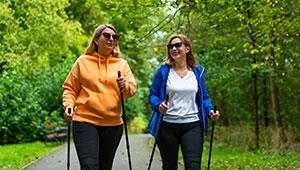
Walking is one of the simplest yet most effective forms of exercise available to us, offering a wide range of benefits for both body and mind. Whether you're strolling through the neighborhood, hiking in nature, or walking on a treadmill, this low-impact activity can transform your health and improve your quality of life. Let's explore the remarkable effects of walking on your body and why it's a valuable addition to any fitness routine.
Why Trust Us?
ACTIVE.com's editorial team relies on the knowledge and experience of fitness and wellness experts, including competitive athletes, coaches, physical therapists, nutritionists, and certified trainers. This helps us ensure that the products we feature are of the highest standard. Collectively, the team has spent countless hours researching equipment, gear, and recovery tools to create the most accurate, authentic content for our readers. Customer satisfaction is also key to our review process, so we only feature highly rated products.
1. Improves Cardiovascular Health
Walking is a cardiovascular exercise that gets your heart pumping and increases blood circulation throughout your body. Regular walking can help lower blood pressure, reduce LDL (bad) cholesterol levels, and improve overall heart health. By strengthening the heart and improving circulation, walking lowers the risk of heart disease, stroke, and other cardiovascular conditions.
2. Boosts Muscle Strength and Endurance:
While walking may seem simple, it engages multiple muscle groups throughout the body, including the legs, hips, core, and upper body. As you walk, these muscles work together to support your body and propel you forward. Over time, regular walking can strengthen and tone these muscles, improving overall muscle strength and endurance.
3. Aids in Weight Management:
Walking effectively burns calories and supports weight loss or weight maintenance efforts. Increasing your daily step count and incorporating brisk walking into your routine can create a calorie deficit that helps you shed excess body fat. Additionally, walking helps boost metabolism and regulate appetite, making it easier to manage weight and prevent weight gain.
4. Enhances Joint Health and Mobility:
Unlike high-impact activities such as running or jumping, walking is gentle on the joints and has a low risk of causing injury or exacerbating joint pain. Regular walking helps lubricate the joints, strengthen the surrounding muscles, and improve flexibility and range of motion. It's an excellent choice for people with arthritis or joint issues who want to stay active and maintain mobility.
5. Supports Mental Well-Being:
Walking isn't just beneficial for the body—it's also good for the mind. Taking a brisk walk outdoors can reduce stress, alleviate anxiety, and improve mood by releasing endorphins, the body's natural feel-good chemicals. Walking in nature has been shown to have particularly positive effects on mental health, promoting relaxation and a sense of well-being.
6. Promotes Longevity and Healthy Aging:
Numerous studies have linked regular walking to a longer lifespan and reduced risk of chronic aging-related diseases, such as diabetes, cancer, and Alzheimer's disease. Walking helps maintain overall health and vitality as we age, keeping the body strong, the mind sharp, and the spirit resilient.
In conclusion, walking is a simple yet powerful form of exercise that offers many benefits for the body and mind. Whether you're aiming to improve cardiovascular health, manage weight, enhance mobility, or boost mood, incorporating regular walking into your daily routine can make a significant difference in your overall well-being. So lace up your shoes, step outside, and start walking your way to better health and vitality today.
Check Out The Latest Walking Shoe Deals From Amazozn
By clicking on the product links in this article, we may receive a commission fee at no cost to you, the reader. Sponsorships and affiliate commissions help support our research so we can help you find the best products. Read full affiliate disclosure here.
About the Author

Stephen is the editor-in-chief of ACTIVE.com. He has been involved in the fitness industry for over twelve years but has been running or playing sports for most of his life.
Get ACTIVE on the Go


Couch to 5K®
The best way to get new runners off the couch and across the finish line of their first 5K.
Available for iOS | Android


Discuss This Article